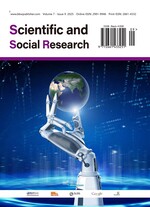An Analysis of Core Competencies for Youth Development in the Age of Artificial Intelligence
Abstract
This paper, through in-depth interviews with 32 people from different groups in four provinces and municipalities, uses the NVivo14 qualitative analysis tool and grounded theory to construct a core literacy system for teenagers in the AI era, which includes three dimensions and 11 elements of knowledge, ability, attitude, and values. Based on the analysis of the interview data, suggestions for cultivating core competencies of teenagers in the AI era, namely AI literacy, innovation literacy, social and emotional literacy, and labor literacy, are proposed.
References
Cui YH, 2016, Literacy: A Concept That Brings Both Joy and Concern. Journal of East China Normal University (Educational Sciences Edition), 34(1): 3–5.
OECD, 2019, OECD Learning Compass 2030. Organisation for Economic Co-operation and Development, Paris. https://www.oecd.org/en/data/tools/oecd-learning-compass-2030.html
Lin CD, 2016, Core Literacy for Chinese Students’ Development. Beijing Normal University Press, Beijing.
Glaser B, 1999, Discovery of Grounded Theory: Strategies for Qualitative Research. Routledge, New York.
Yin KG, 2024, AI Literacy: Background of Proposal, Conceptual Definition, and Constituent Elements. Library and Information, 2024(3): 60–68.
Chu HQ, 2016, The Concept and Essence of Core Literacy. Journal of East China Normal University (Educational Sciences Edition), 34(1): 1–3.
Yang X, 2024, Youth and AI: Cognitive Attitudes and Improvement of Digital Literacy. People’s Tribune, 2024(11): 59–61.
Cheng QX, Liu W, Xu D, 2024, Digital Technology Empowering Labor Education: Innovation, Challenges, and Strategies. Basic Education Reference, 2024(11): 61–66.
Gan QL, Bai XW, Liu J, et al., 2020, Innovative Literacy: The Third Dimension of the 21st-Century Core Literacy 5C Model. Journal of East China Normal University (Educational Sciences Edition), 38(2): 57–70.
Jiang L, 2023, AI-Driven Educational Reform: The Impact and Outlook of ChatGPT/GPT. Journal of East China Normal University (Education Edition), 41(7): 143–150.
Chen SY, 2021, Teaching Presence: Teachers’ Professional Connection in the Context of Digital Intelligence. Teacher Education Research, 33(6): 58–63.
Huang ZJ, Li J, 2025, The Three Pillars for Promoting Students’ Social and Emotional Competence: Peer Relationships, Teacher-Student Relationships, and Family Relationships. Research in Educational Development, 45(10): 16–27.
Huang SL, Lin CD, 2018, The Connotation and Structure of Social Responsibility Literacy. Journal of Beijing Normal University (Social Sciences Edition), 2018(1): 27–33.
Liu J, Wei R, Liu S, et al., 2016, Research Design of “Facing the Future: Global Experience in 21st-Century Core Literacy Education”. Journal of East China Normal University (Educational Sciences Edition), 34(3): 17–21 + 113.
Wu WW, Shao GH, 2019, How to Implement Core Literacy of Logical Reasoning in Primary School Mathematics Classrooms. Curriculum, Teaching Material, and Method, 39(3): 88–95.

